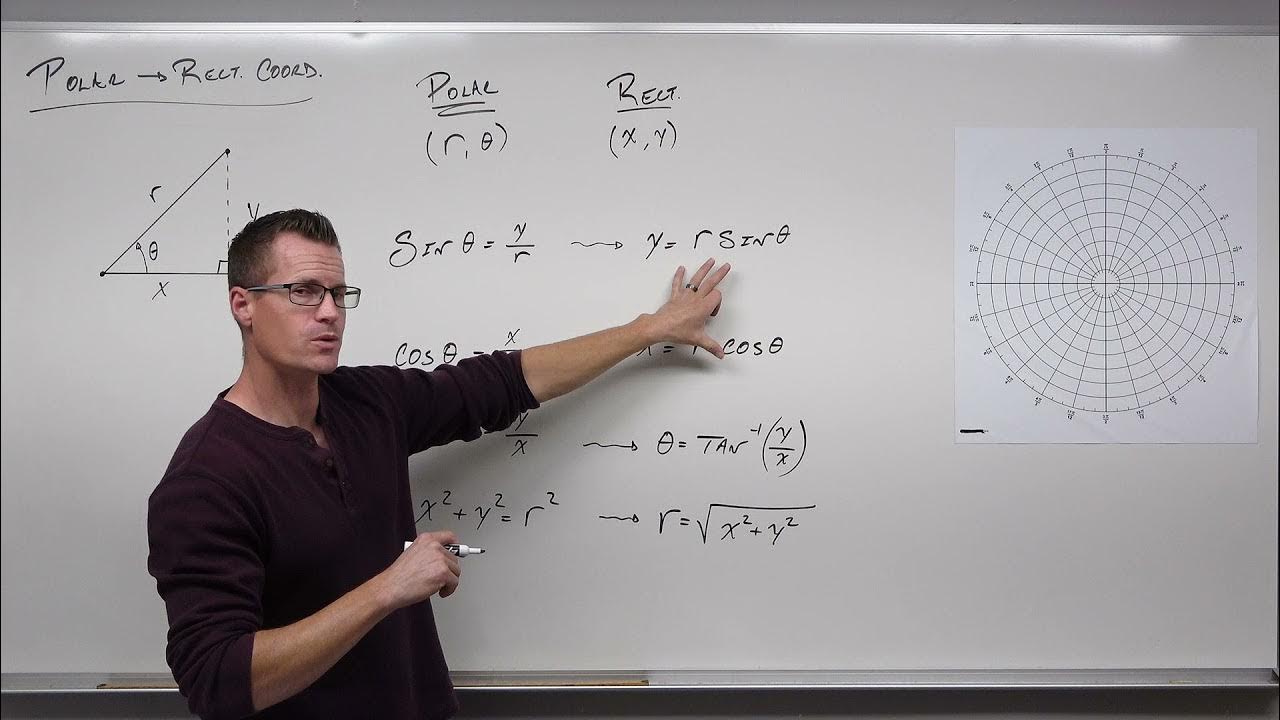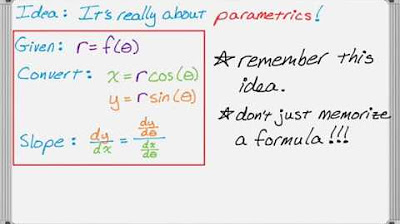Polar coordinates 3 | Parametric equations and polar coordinates | Precalculus | Khan Academy
TLDRThis video script offers a detailed tutorial on converting Cartesian functions to polar coordinates and vice versa. It begins with the conversion of the equation 3y - 7x = 10 into polar form, utilizing trigonometric identities and algebraic manipulation. The script then demonstrates converting y = 2x - 3 into polar coordinates, followed by examples of converting polar equations like r = 4sin(θ) and r = sin(θ) + cos(θ) back into Cartesian form. The process involves substituting r and θ with their respective expressions in terms of x and y, and simplifying the equations. The script concludes with a discussion on the graphical representation of these equations and the intuition behind the relationships between r and θ.
Takeaways
- 📝 Converting Cartesian functions to polar coordinates involves substituting x and y with r and theta.
- 🔍 For the equation 3y - 7x = 10, substitute y = r sin(theta) and x = r cos(theta) to get r in terms of theta.
- 🔧 After substitution, factor out r to simplify the equation and solve for r.
- 💡 The function r in terms of theta can be written as r = 10 / (3 sin(theta) - 7 cos(theta)).
- 🔄 For the equation y = 2x - 3, use the same substitution method and factor out r.
- 📐 After factoring and simplifying, the equation r = -3 / (sin(theta) - 2 cos(theta)) is obtained.
- 🔄 To convert from polar to Cartesian coordinates, use the given polar function r = 4 sin(theta) and replace sin(theta) and cos(theta) with y/r and x/r respectively.
- 🔗 Multiply through by r to eliminate the denominator and use r^2 = x^2 + y^2 to convert to Cartesian coordinates.
- 🔢 For the polar function r = sin(theta) + cos(theta), substitute sin(theta) = y/r and cos(theta) = x/r, then simplify.
- 📊 Converting polar to Cartesian coordinates often involves algebra and trigonometry to express the relationship in terms of x and y.
Q & A
What is the purpose of converting Cartesian functions to polar coordinates?
-The purpose of converting Cartesian functions to polar coordinates is to express the relationship between variables in a different coordinate system that might be more suitable for certain problems, especially those involving circular or radial symmetry.
What is the Cartesian equation given in the script to be converted to polar coordinates?
-The Cartesian equation given is 3y - 7x = 10.
How are y and x represented in terms of polar coordinates?
-In polar coordinates, y is represented as r * sin(theta) and x is represented as r * cos(theta), where r is the radius and theta is the angle from the positive x-axis.
What is the result of substituting y and x with their polar coordinate equivalents in the equation 3y - 7x = 10?
-After substitution, the equation becomes 3(r * sin(theta)) - 7(r * cos(theta)) = 10.
What is the simplified form of the equation after factoring out r?
-After factoring out r, the equation simplifies to r * (3 * sin(theta) - 7 * cos(theta)) = 10.
What is the final form of the equation in polar coordinates after dividing by the expression (3 * sin(theta) - 7 * cos(theta))?
-The final form is r = 10 / (3 * sin(theta) - 7 * cos(theta)).
How is the function r(theta) related to the polar coordinates conversion?
-The function r(theta) represents the radius as a function of the angle theta, which is a way to express the relationship between r and theta in polar coordinates.
What is the Cartesian equation y = 2x - 3 converted to in terms of polar coordinates?
-After conversion, the equation becomes r * sin(theta) = 2 * (r * cos(theta)) - 3, which simplifies to r * (sin(theta) - 2 * cos(theta)) = -3.
What is the polar function r = 4 * sin(theta) converted to in Cartesian coordinates?
-The polar function r = 4 * sin(theta) converts to the Cartesian equation x^2 + y^2 - 4y = 0.
How does the script describe the process of converting polar coordinates to Cartesian coordinates?
-The script describes the process by using the relationships y/r = sin(theta) and x/r = cos(theta) to substitute and simplify the polar equations into Cartesian form.
What is the significance of the polar function r = a^2?
-The polar function r = a^2 represents a circle with a constant radius of 'a' in polar coordinates, which, when converted to Cartesian coordinates, becomes the equation x^2 + y^2 = a^4.
How does the script suggest visualizing the relationships between r and theta?
-The script suggests using a graphing calculator set to polar coordinates to visualize the relationships and to see how the radius changes as theta varies.
Outlines
📐 Converting Cartesian to Polar Coordinates
This paragraph explains the process of converting a Cartesian function to polar coordinates. It begins with the equation 3y - 7x = 10 and substitutes y with r * sin(θ) and x with r * cos(θ), leading to an expression in terms of r and θ. The paragraph demonstrates algebraic manipulation to isolate r, resulting in r = (10 * sin(θ) - 7 * cos(θ)) / 3. It also covers another example, y = 2x - 3, and shows the conversion to polar form, ending with r = -3 / (sin(θ) - 2 * cos(θ)). The focus is on using trigonometric identities and algebra to perform the conversions.
🔄 Converting Polar to Cartesian Coordinates
The second paragraph delves into converting polar functions to Cartesian coordinates. It starts with the polar function r = 4 * sin(θ) and uses the relationships y = r * sin(θ) and x = r * cos(θ) to convert it into Cartesian form, resulting in x^2 + y^2 = 4y. The paragraph also discusses the conversion of r = sin(θ) + cos(θ) to Cartesian coordinates, which leads to x^2 + y^2 = y + x. Lastly, it touches on the concept of a circle in polar coordinates, given by r = a^2, and its Cartesian equivalent, x^2 + y^2 = a^4. The summary emphasizes the algebraic steps and the use of the toolkit for conversions between the two coordinate systems.
Mindmap
Keywords
💡Cartesian coordinates
💡Polar coordinates
💡Conversion
💡r sine of theta
💡r cosine of theta
💡SOHCAHTOA
💡Algebra
💡Trigonometry
💡Implicit equation
💡Graphing calculator
💡Toolkit
Highlights
The process of converting Cartesian functions to polar coordinates is introduced.
Substitution of Cartesian coordinates (x, y) with polar coordinates (r, θ) using y = r * sin(θ) and x = r * cos(θ).
Simplification of the equation 3y - 7x = 10 into polar form results in r * (3sin(θ) - 7cos(θ)) = 10.
Factoring out r from the equation to express r as a function of θ.
Conversion of the equation y = 2x - 3 into polar coordinates by isolating r and θ variables.
Factoring out r from the equation r * (sin(θ) - 2cos(θ)) = -3 to find r in terms of θ.
The conversion of polar function r = 4 * sin(θ) into Cartesian coordinates by using algebraic manipulation.
Derivation of the Cartesian form x² + y² = 4y from the polar equation r = 4 * sin(θ).
Use of trigonometric identities and algebra to convert polar to Cartesian coordinates.
Introduction of the polar function r = sin(θ) + cos(θ) and its potential graphing on a polar coordinate system.
Substitution of sin(θ) = y/r and cos(θ) = x/r to convert r = sin(θ) + cos(θ) into Cartesian form.
Result of the conversion is the equation r² = y + x, which is then identified as x² + y².
Abstract polar equation r = a² is discussed, indicating a constant radius circle in Cartesian coordinates.
Conversion of r = a² into Cartesian coordinates by squaring both sides, resulting in x² + y² = a⁴.
Emphasis on the importance of algebra and trigonometry in converting between Cartesian and polar coordinates.
A promise to explore the graphs of these equations in future videos to provide more intuition.
The video concludes with a summary of the algebraic process for converting between coordinate systems.
Transcripts
Browse More Related Video

How to Convert From Polar Coordinates to Rectangular Coordinates (Precalculus - Trigonometry 37)

How to Convert From Rectangular Equations to Polar Equations (Precalculus - Trigonometry 39)

Polar Equations to Rectangular Equations, Precalculus, Examples and Practice Problems

Polar coordinates 2 | Parametric equations and polar coordinates | Precalculus | Khan Academy

Finding Slope of a Polar Curve in Calculus

How To Graph Polar Equations
5.0 / 5 (0 votes)
Thanks for rating: